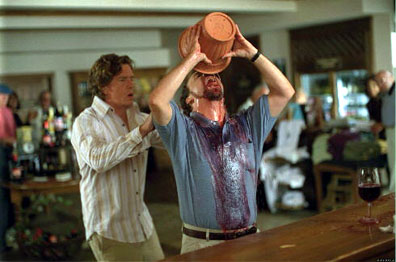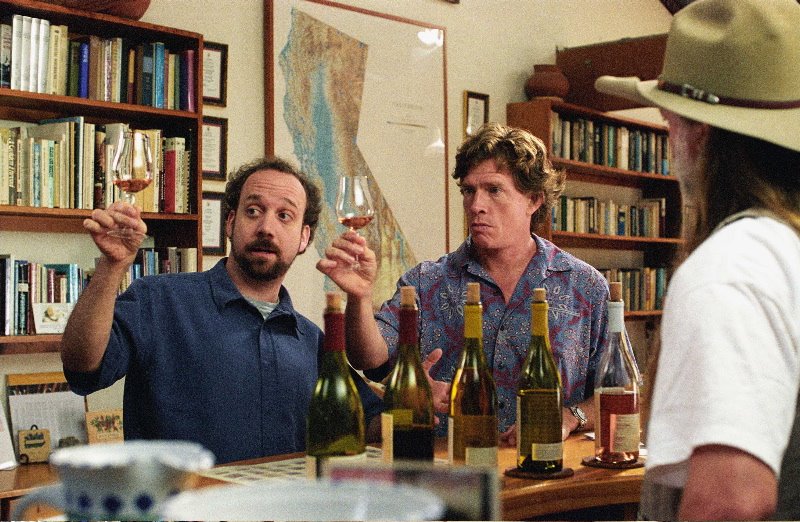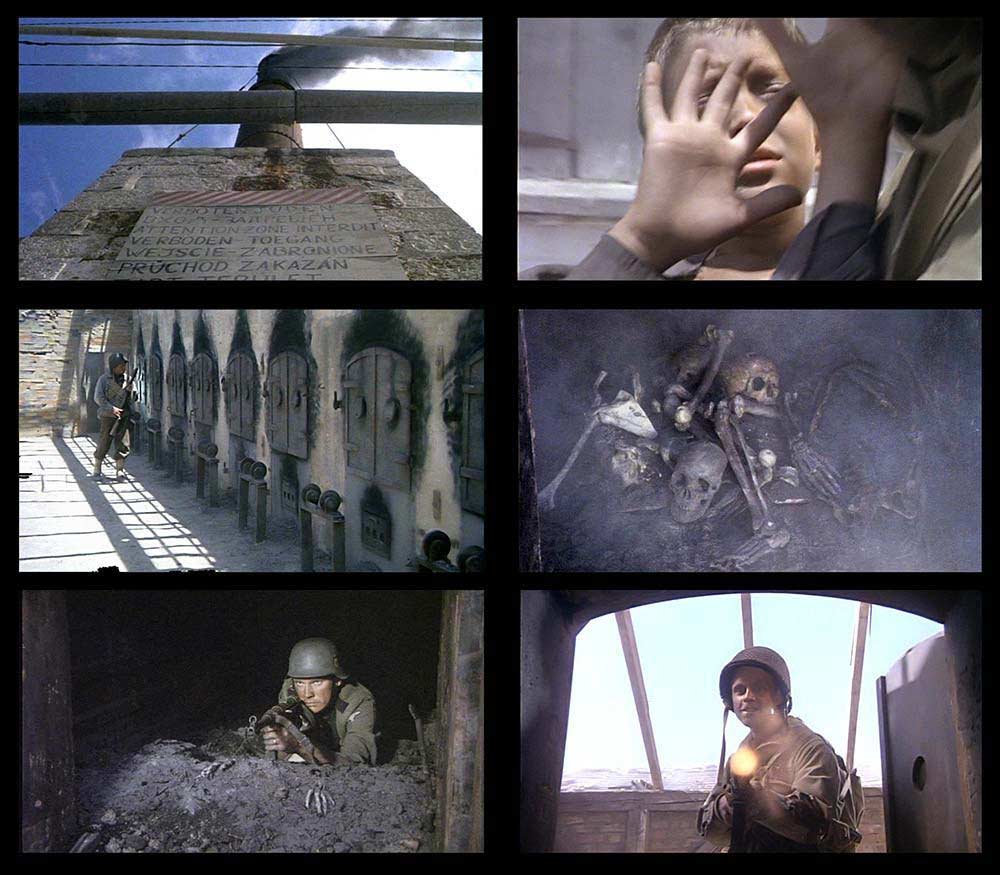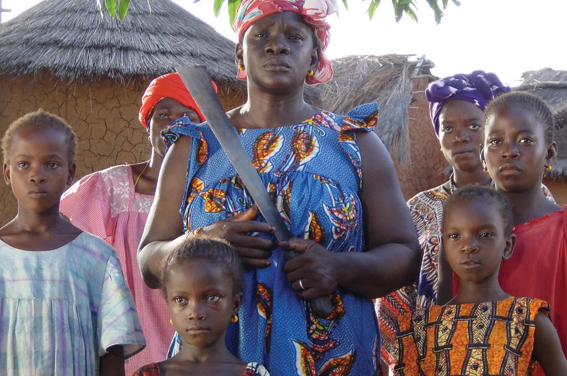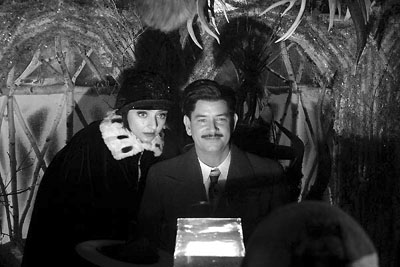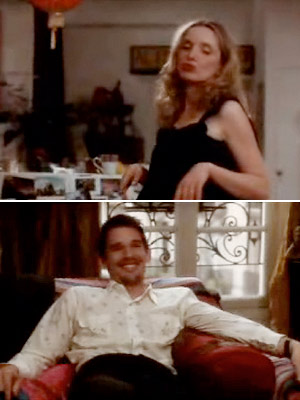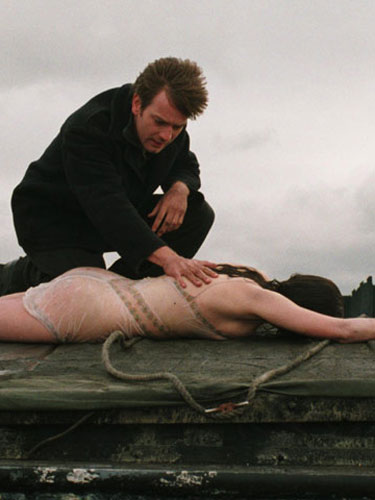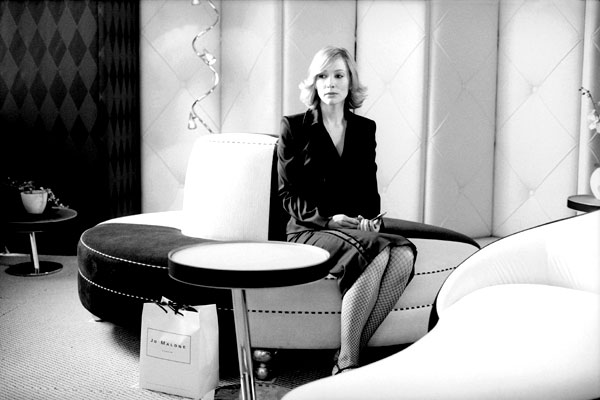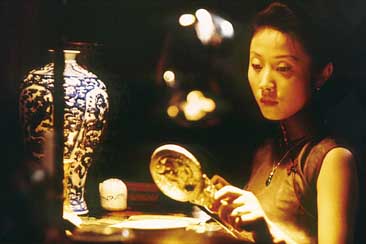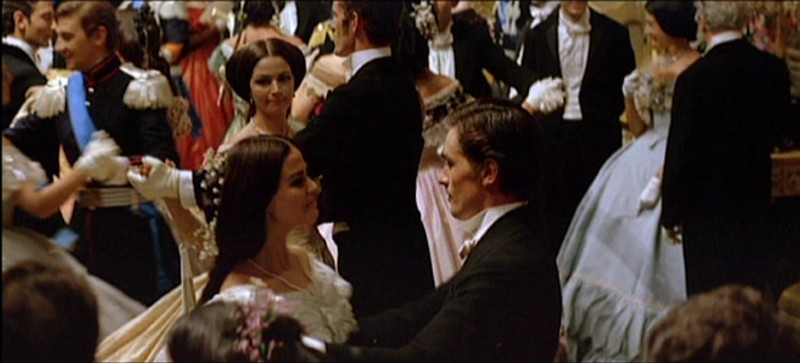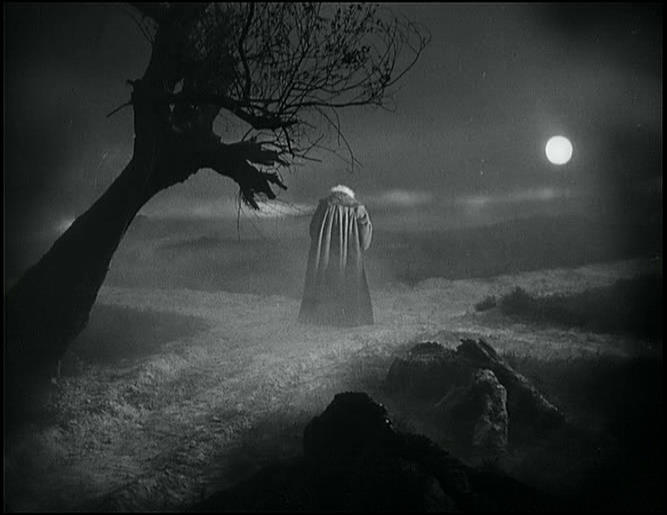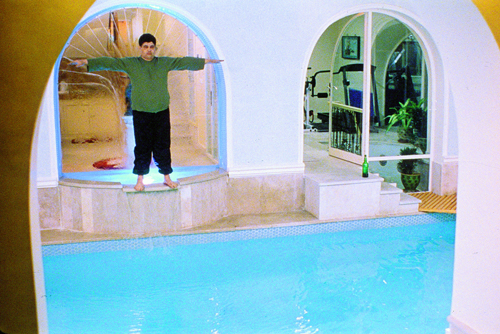From the Chicago Reader (January 7, 2005). — J.R.
Ten film critics’ polls in Chicago, Boston, Los Angeles, New York, San Francisco, Toronto, and Washington, D.C., have named Sideways the best movie of the year. I don’t know whether to laugh or cry.
It’s not that I have anything against comedies; last year Down With Love was second on my ten-best list. Besides, Sideways has a dark side — its infantile hero (Paul Giamatti) steals from his mother, and his infantile sidekick (Thomas Haden Church), who’s about to be married, compulsively cheats on his fiancee. They behave as if the world beyond southern California doesn’t exist, but the movie doesn’t seem to realize it. And like most American mainstream movies, it dances around class issues without ever facing them.
If my colleagues who love this movie, many of whom I admire, are implying that it contains valuable life lessons, I wish they’d tell me what they are. Giamatti is an acerbic loser hero who’s eventually given a ray of hope, like the Woody Allen hero of 20 or 30 years ago but without the wisecracks. So is regressing to that moviemaking model the proudest achievement of world cinema in 2004? Did the critics find something comforting, even affirmative, about its provincialism?
Stumped, I watched it again. An utter waste of time. It has no secrets to yield, no mysteries to clear up — except maybe the meaning of its title. I have to admit it’s flawlessly executed — in the same way that a Fig Newton can be flawless. As art, aside from some first-rate acting and swell casting (Church, Giamatti, Virgina Madsen), it’s almost completely without interest. As entertainment, it’s OK — the sort of thing people can fall asleep watching on late-night cable. As social observation, it’s knowledgeable yet familiar. I’ve lived in both San Diego and the Santa Barbara area, where most of the story is set, and I recognize the people, the weather, the restaurants, the wine bars, the golf courses, even a few boring and boredom-inspired southern California habits, like doing newspaper crossword puzzles on the freeway. Maybe one reason I don’t like the movie more is that I don’t miss any of this.
Director and cowriter Alexander Payne has nothing to say about over-the-hill males that we don’t already know or couldn’t find in a sitcom. The main characters, pals driving north from San Diego for a few days of vacation, are a depressive, recently divorced wine snob and schoolteacher (Giamatti) who can’t publish his novel and his former college roommate (Church), a cheerful TV actor the movie eventually discards. The music is a Muzak imitation of the Modern Jazz Quartet, and Payne isn’t doing anything special with the images and sounds. Overall the film is unoriginal and unchallenging — unless one considers an obsession with wine a daring subject.
In short, Sideways is the best piece of routine cynicism around, though some critics are calling it “humanism.” The last time I looked it was number 115 on Variety‘s chart of the year’s top moneymakers. So I’m obliged to conclude that it’s not the public but some of my colleagues who expect so little from movies. In the New York Times last Sunday A.O. Scott helped start the inevitable backlash by theorizing that critics may be overrating the movie because they identify with Giamatti the wine critic. I’m more prone to think it might be their way of saying, “It’s been a tough year. Let’s get back under the blankets.”
It has been a bad year, but not for movies. It was such a strong year for documentaries, in overall quality and public reception, that I easily could have come up with a ten-best list devoted exclusively to them. There was Fahrenheit 9/11, Michael Moore’s best film to date; Outfoxed: Rupert Murdoch’s War on Journalism, which didn’t play in theaters but was briefly the country’s best-selling DVD on Amazon; Abbas Kiarostami’s Five, which still hasn’t reached Chicago; the collectively made About Baghdad; Ross McElwee’s Bright Leaves; Mark Achbar, Jennifer Abbott, and Joel Bakan’s The Corporation; Jehane Noujaim’s Control Room; Deborah Stratman’s Kings of the Sky; Babette Mangolte’s Les modeles de “Pickpocket”; Peter Thompson’s El Movimiento; Chris Marker and Yannick Bellon’s Remembrance of Things to Come; Michel Khleifi and Eyal Sivan’s Route 181: Fragments of a Journey in Palestine-Israel; and Michael Almereyda’s This So-Called Disaster. Though far from being exhaustive, this list indicates how precious documentaries have become in filling the enormous holes in TV news coverage and documentaries, especially when it comes to the world outside our borders.
My ten-best list below is limited to new films that played in Chicago last year. Unfortunately this rules out the best new film I saw anywhere, Jia Zhang-ke’s The World, but it’s been picked up for U.S. distribution and will turn up here eventually. Tsai Ming-liang’s superb Goodbye, Dragon Inn, which played at the Chicago International Film Festival in 2003, is on many critics’ lists; I couldn’t include it because it didn’t play here in 2004, though it opens at the Music Box this week.
1. The Big Red One: The Reconstruction
For all its richness, Samuel Fuller’s longest and most ambitious feature isn’t his greatest; the leading contenders for that would be The Steel Helmet (1950), Park Row (1952), and Pickup on South Street (1953). As a compendium of his combat experience during World War II — which should be placed alongside the extended account offered in his autobiography, A Third Face — it lacks the focus and concentration of those early masterpieces. Nevertheless, it’s his most complex and layered effort, the one most charged with mystery and ambiguity — which is apparent even in the severely truncated version released in 1980.
Richard Schickel’s invaluable new version isn’t a restoration of any previous cut but a recasting and extension of the available material that draws on Fuller’s screenplay and notes, making more of his expressive range apparent — in the subplots and interludes and in the performance of Lee Marvin, one of his finest. Moving from realism to surrealism, parable to allegory, comedy to tragedy, Fuller is concerned above all with what combat felt like and what sort of sense could be made of it. A lifetime of reflection clearly went into this project. What a pity it couldn’t appear in something close to its intended form until seven years after his death.
2. Million Dollar Baby
This masterful noir heartbreaker is Clint Eastwood’s best feature to date, in part because it combines his own best performance and his best script (adapted by Paul Haggis from stories by the late F.X. Toole). Its only rival in both departments is White Hunter, Black Heart, which also has a literary sensibility (adapted by Peter Viertel, James Bridges, and Burt Kennedy from Viertel’s novel) and some sharp acting by Eastwood (imitating John Huston so that we see Huston and Eastwood as if in a double exposure — a mockery of both personas that I’d call Brechtian). In both films we wind up with a more emotionally vulnerable Eastwood than we’re accustomed to, filtered through the viewpoint of another male — Morgan Freeman in Million Dollar Baby (another very strong performance) and Jeff Fahey in White Hunter, Black Heart. White Hunter is also a blistering critique of the Hemingway ethic, and Million Dollar Baby emulates the spareness and stoicism of some of Hemingway’s early stories in order to reveal the depths of pain underneath placid surfaces. In the new film the pain is felt mainly by Eastwood and the lonely hillbilly woman (Hilary Swank) he trains as a boxer. If Million Dollar Baby ultimately comes across as a love story, it’s a decidedly unromantic kind — a pact between strangers to replace the families they no longer have that registers as both precious and radically uncompromised. Eastwood also deserves credit for being the only Hollywood director (at least to my knowledge) who has the inclination and clout to refuse to let his films be test-marketed.
3. Moolaade
It isn’t surprising that this masterpiece by Africa’s greatest filmmaker, 82-year-old Ousmane Sembene, had only a brief run at the Music Box last month. His films rarely get shown outside of college courses — I’ve seen just over half of them myself — and he may be the only major narrative filmmaker whose works aren’t available on VHS or DVD in the U.S., though he says this is about to change. (In France you can get a set of six titles on DVD, but there are no English subtitles.)
The second film in a trilogy celebrating African women — after Faat Kine, an exuberant 2000 comedy about a sassy, self-made city woman — Moolaade focuses on the defiant second wife of an elder in a West African village. She refuses to allow four little girls to undergo the traditional genital mutilation, and the deceptive simplicity and apparent looseness of the storytelling and characterizations, like those of Sembene’s prose fiction (much of which is available in English), allow the drama to steadily gather momentum and political force. These characters are far more representative of the world’s population than any of those in Sideways, and the cagey, multilayered treatment of a local merchant who in some ways represents the world outside the village is emblematic of Sembene’s calm virtuosity.
4. Los Angeles Plays Itself
I was gratified to see Thom Andersen’s masterpiece named the year’s best documentary in the Village Voice‘s recent poll of almost 100 critics, garnering more than twice as many votes as either Bright Leaves or Fahrenheit 9/11. The same poll put Before Sunset, Eternal Sunshine of the Spotless Mind, and Dogville ahead of Sideways, which led the online Movie City News to call it “The Village Voice Poll of the Effete Critiques,” though it’s hard to imagine many movies more effete than Sideways.
Andersen examines 191 cinematic depictions of Los Angeles over 169 minutes, yielding the best sustained work of film criticism I encountered all year. Unabashedly crotchety and often hilarious as it juxtaposes the city itself with almost a century’s worth of fantasy about it, this essay about local folklore, architecture, real estate, car culture, mass transit, and lost neighborhoods and lifestyles never loses sight of what the movies in question are doing as movies.
5. The Exiles
One of the lesser-known films singled out for appreciation in the closing stretches of Los Angeles Plays Itself is this independent film from 1961, the debut feature of Kent Mackenzie (who died in 1980). It had been out of circulation for ages until Andersen included clips from it in his film and persuaded programmers to screen it alongside his film. It captures a slice of one Friday night and Saturday morning, in the now- vanished working-class district of Bunker Hill, as experienced by a few uprooted Native Americans. Not clearly classifiable as either fiction or documentary, it features exquisite black-and-white cinematography, nonprofessional actors improvising the dialogue and internal monologues, and only a few brief flashbacks to reservation life, which are stylistically less convincing than the rest of the film. Its distilled urban poetry leaves a sharp aftertaste.
6. The Saddest Music in the World
Less avant-garde and autobiographical than his Cowards Bend the Knee (originally part of a gallery installation and screened here late in 2003 at the Gene Siskel Film Center), Guy Maddin’s sorrowful, satirical, and mannerist Depression musical represents a new expressive plateau in his work. The plot — an Americanized Canadian antihero (Mark McKinney) competes as an American in an absurd musical competition sponsored by a brewery in Maddin’s native Winnipeg — says more about what it means to be Canadian (and therefore not American) than any of Maddin’s other features, making the movie a hilariously bittersweet allegory about U.S. imperialism that couldn’t have been more timely. Pushing his taste for melodrama to the utmost, with the welcome assistance of Isabella Rossellini and Maria de Madeiros, Maddin the antiquarian paradoxically remains one of North America’s most up-to-date filmmakers.
7. Before Sunset
Few movie sequels equal or top their predecessors, but Richard Linklater’s follow-up to his 1995 love story Before Sunrise is one of them. The first film paired Julie Delpy with Ethan Hawke in Vienna much as The Clock paired Judy Garland with Robert Walker in Manhattan, using the city over the course of a day as both the instigator of romance and a kibitzing chorus. Before Sunset is set nine years later, with Delpy and Hawke reunited in Paris for 80 real-time minutes. This time the presiding film influence is Eric Rohmer: the talk between the two is fairly constant, and the sexual tease and mutual seduction is continuous. Linklater and his couple are older and wiser and decidedly less certain about the future, which makes for a lot of suspense and for a romance recast in existential terms.
8. Young Adam
In some ways the year’s biggest surprise was writer-director David Mackenzie’s second feature, which revealed a masterful cinematic and narrative intelligence. He proved himself even more existential than Linklater as he adapted a 1953 beat novel about a nihilistic and unlikable bargeman (Ewan McGregor) working the canals between Edinburgh and Glasgow and reading and screwing in his spare time. Mackenzie charts the hero’s emotional detachment through a flashback structure built around the sudden death of one of his lovers (Emily Mortimer) and his adulterous tumbles with another (Tilda Swinton), and often comes across like a Scottish Albert Camus, with an original way of handling both period ambience and clammy sex.
9. Coffee and Cigarettes
The early episodes in Jim Jarmusch’s minimalist comedy series, which grew out of a 1986 Saturday Night Live sketch, struck me as at best amiable throwaways. But when he finally got around to expanding it into this 11-part feature, he gave it thematic weight and musical balance and development, as well as a personal edge that goes well beyond the hip posturing his detractors condemn. This edge is most apparent in the two episodes concerned with the dodgy ethics of celebrity — Cate Blanchett brilliantly playing both herself and her resentful punk cousin in one, Alfred Molina and Steve Coogan coolly sparring for preeminence in another — and in the final episode, where Bill Rice and Taylor Mead help Jarmusch pay tribute to his roots in the New York underground of the 70s. But there are flashes of wit and insight throughout.
10. Springtime in a Small Town
China’s most talented young filmmaker is Jia Zhang-ke, and his most gifted predecessor is Tian Zhuangzhuang, whose controversial The Blue Kite (1993) put his career in mothballs for a decade. This sensitive and probing film is his comeback. As a test and challenge to himself, he chose to remake the most highly regarded film among speakers of Chinese, Fei Mu’s awesome 1948 Spring in a Small Town. He hasn’t matched that masterpiece, but this five-character chamber drama about unconsummated adulterous passion unfolding in the ruins of a mansion in southern China in 1946 — three years before the communist revolution — is still a triumph.
Fei Mu’s original isn’t available with English subtitles, one more reminder that our sense of film history takes in only the tip of the iceberg. Because nobody can see everything, I probably missed some of the year’s best movies. But readers who’ve chided me in the past for putting too much emphasis on foreign films in my annual lists should note that six of my selections this time are American and eight were made in English. Admittedly only two of them are from Hollywood, but neither has suffered from the usual studio interference.
Any other year my annual F.W. Murnau award, given to the film or films that did the most to alter my sense of film history, would probably have gone to the Murnau retrospective mounted at the Gene Siskel Film Center. But this was a big year for splendid revivals, including Boris Barnet’s Okraina and By the Bluest of Seas, The Battle of Algiers, The New Babylon, Piccadilly, Bitter Victory, and Queimada. And great as Murnau’s work still is, the work of another painterly master had an even deeper impact on me — the expanded Italian version of Luchino Visconti’s The Leopard, a portrait of a dying aristocracy that’s second only to Orson Welles’s The Magnificent Ambersons.
If all those critics who chose Sideways as the best picture of 2004 truly intended to say this was a disappointing year for movies, I can only conclude they went to the wrong ones. I can think of two dozen more films shown in Chicago that could easily have made it into my top ten: The Aviator, The Blind Swordsman: Zatoichi, The Blonds, Collateral, Crimson Gold (which topped my list last year but opened here in theaters in 2004), Dear Frankie, Distant, Ere Erera Baleibu Icik Subua Aruaren, Eternal Sunshine of the Spotless Mind (which was dismissed by the French press, despite or because of its indebtedness to Alain Resnais, whose gorgeous latest film has yet to open here), Ford Transit, Kinsey, Notre musique, The Return (the best first feature I saw), Saved!, The Sea Inside, Spanglish (in spite of its flaws), Star Spangled to Death, Stray Dogs, The 10th District Court: Judicial Hearings, Time of the Wolf, The Tracker, Undertow, Vera Drake, and The Yes Men. Not a perfect lineup, but plenty to chew on — lots more than in Sideways.

